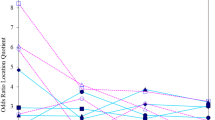Abstract
Which black communities in cities beneath the Mason-Dixon Line (demarcating the US South and North) enhanced blacks’ entry into occupations of the early twentieth-century Black Metropolis? (that is, professional, entrepreneurial, public service, and cultural production occupations). An answer to this question informs theory and research on the urban South’s black communities. Census data analyses address the question, testing hypotheses about position, place, and population effects. Washington, DC’s border position and place-related advantages enhanced blacks’ entry into all Black Metropolis occupations, net of the city’s sizable black population. These advantages, stemming from the city’s unique role as the nation’s capital and its venerable black elite class, made Washington, DC’s black community a prime location for the southern Black Metropolis, contrary to arguments that Black Metropolises could not exist below the Mason-Dixon Line in the early twentieth century.
Similar content being viewed by others
References
Aldrich, H., Cater, J., Jones, T., McEvoy, D., & Vellman, P. (1985). Ethnic residential concentration and the protected market hypothesis. Social Forces, 63(4), 996–1009.
Blalock, H. M., Jr. (1967). Toward a theory of minority-group relations. New York: John Wiley and Sons.
Borjas, G. J. (1995). Ethnicity, neighborhoods, and human-capital externalities. American Economic Review, 85(3), 365–390.
Boyd, R. L. (1996). The great migration to the north and the rise of ethnic niches for African American women in beauty culture and hairdressing, 1910-1920. Sociological Focus, 29(1), 33–45.
Boyd, R. L. (2007). Historically black colleges and universities and the black business elite. Sociological Perspectives, 50(4), 545–560.
Boyd, R. L. (2009a). Depletion of the south’s human capital: the case of eminent black entrepreneurs. Southeastern Geographer, 49(3), 251–266.
Boyd, R. L. (2009b). Urban locations of eminent black entrepreneurs in the United States. Urban Studies, 46(10), 2061–2078.
Boyd, R. L. (2015). The ‘black metropolis’ in the American urban system of the early twentieth century: Harlem, Bronzeville, and beyond. International Journal of Urban and Regional Research, 39(1), 129–144.
Breton, R. (1964). Institutional completeness of ethnic communities and the personal relations of immigrants. American Journal of Sociology, 70(2), 193–205.
Butler, J. S. (2005). Entrepreneurship and self-help among black Americans: a reconsideration of race and economics. Albany: State University of New York Press.
Fischer, C. S. (1975). Toward a subcultural theory of urbanism. American Journal of Sociology, 80(6), 1319–1341.
Florida, R. (2002). The economic geography of talent. Annals of the Association of American Geographers, 92(4), 743–755.
Frazier, E. F. (1957). The Negro in America. New York: Macmillan.
Gatewood, W. B. (1990). Aristocrats of color: the black elite, 1880–1920. Bloomington: Indiana University Press.
Gregory, J. N. (2005). The southern diaspora: how the great migrations of black and white southerners transformed America. Chapel Hill: University of North Carolina Press.
Grigoryeva, A., & Ruef, M. (2015). The historical demography of racial segregation. American Sociological Review, 80(4), 814–842.
Hawley, A. H. (1972). Population density and the city. Demography, 9(4), 521–529.
Higgs, R. (1976). Participation of blacks and immigrants in the American merchant class, 1890–1910: some demographic relations. Explorations in Economic History, 13(2), 153–164.
Ingham, J. N. (2003). Building businesses, creating communities: residential segregation and the growth of African American business in southern cities, 1880-1915. The Business History Review, 77(4), 639–665.
Johnson, C. S. (1943). Patterns of Negro segregation. New York: Harper and Brothers.
Lieberson, S. (1980). A piece of the pie: blacks and white immigrants since 1880. Berkeley: University of California Press.
Massey, D. S., & Denton, N. A. (1993). American apartheid: segregation and the making of the underclass. Cambridge: Harvard University Press.
Meier, A. (1963). Negro thought in America, 1880-1915: racial ideologies in the age of Booker T. Washington. Ann Arbor: University of Michigan Press.
Meier, A., & Rudwick, E. (1976). From plantation to ghetto. New York: Hill and Wang.
Myrdal, G. (1944). An American dilemma. New York: Harper and Brothers.
Ogburn, W. F., & Duncan, O. D. (1964). City size as a sociological variable. In E. W. Burgess & D. J. Bogue (Eds.), Contributions to urban sociology (pp. 129–147). Chicago: University of Chicago Press.
Pearce, D. W. (1986). The MIT dictionary of modern economics. Cambridge: The MIT Press.
Rabinowitz, H. N. (1980). Race relations in the urban south, 1865-1890. Urbana: University of Illinois Press.
Reed, C. R. (2011). The rise of Chicago’s black metropolis, 1920–1929. Urbana: University of Illinois Press.
Sowell, T. (1981). Ethnic America: a history. New York: Basic Books.
U.S. Bureau of the Census. (1933a). Census of population: 1930. Volume 2. General report: Statistics by subjects. Washington, DC: U.S. Government Printing Office.
U.S. Bureau of the Census. (1933b). Census of population: 1930. Volume 4. Occupations by states. Washington: U.S. Government Printing Office.
U.S. Bureau of the Census. (1933c). Census of population: 1930. Volume 5. General report on occupations. Washington, DC: U.S. Government Printing Office.
Waldinger, R. (1996). Ethnicity and opportunity in the plural city. In R. Waldinger & M. Bozorgmehr (Eds.), Ethnic Los Angeles (pp. 445–470). New York: Russell Sage Foundation.
Author information
Authors and Affiliations
Corresponding author
Additional information
Publisher’s Note
Springer Nature remains neutral with regard to jurisdictional claims in published maps and institutional affiliations.
Rights and permissions
About this article
Cite this article
Boyd, R.L. Southern Black Metropolis: Position, Place, and Population Below the Mason-Dixon Line. J Afr Am St 23, 256–272 (2019). https://doi.org/10.1007/s12111-019-09441-x
Published:
Issue Date:
DOI: https://doi.org/10.1007/s12111-019-09441-x




